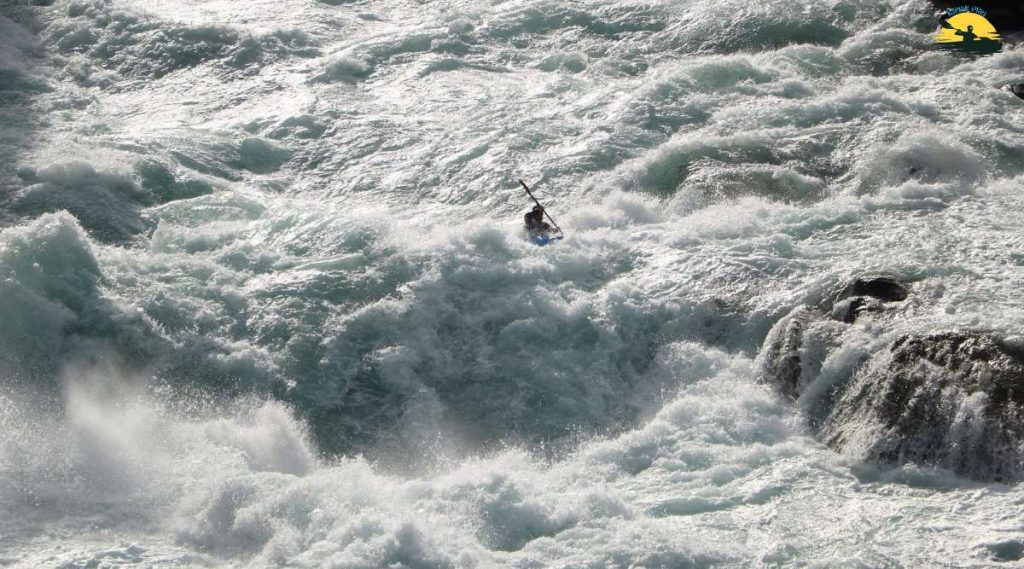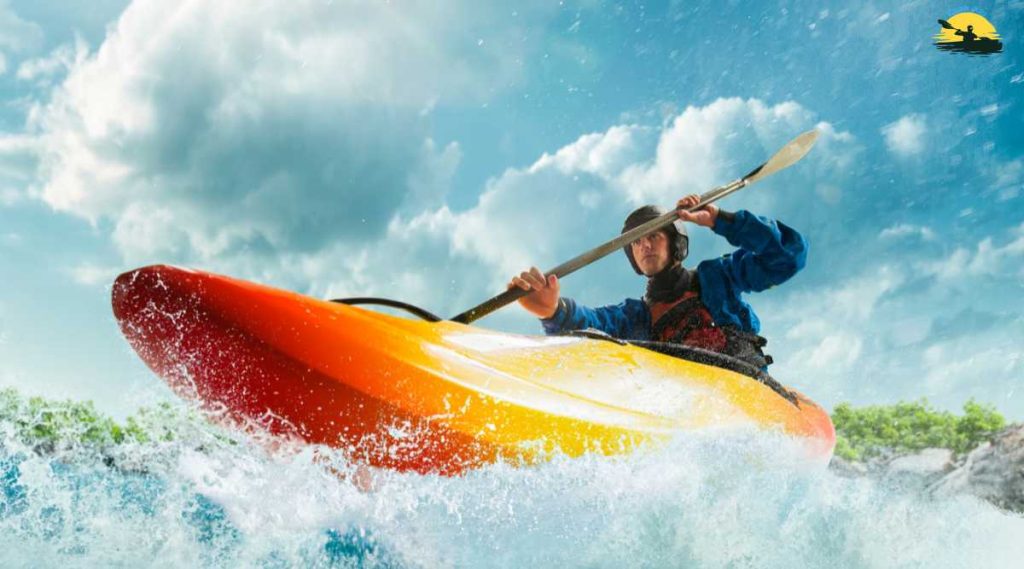Introduction
Is Kayaking an Extreme Sport? Kayaking can be done on different types of bodies of water, such as lakes, rivers, oceans, and even whitewater rapids. Now, the question is whether kayaking is just a leisure activity for nature lovers or an extreme sport.
The debate over whether kayaking is an extreme sport continues to stir excitement among adventure seekers worldwide. Let’s dive deeper to uncover the real essence of kayaking. Be with me till the end.
Table of Contents
Is Kayaking an Extreme Sport?
Is Kayaking an Extreme Sport? Kayaking can be an extreme sport. Leisurely paddling in calm lakes is not extreme. Some types of kayaking push the boundaries of adventure and adrenaline.
Whitewater kayaking puts paddlers in turbulent waters. Navigating the rocky river requires skill, quick reflexes, and strong nerves.
Risk of unexpected fast-moving water and capsizing or splashing injuries. This makes kayaking extremely challenging.

Sea kayaking has its challenges. Paddlers must contend with strong ocean currents and unpredictable weather conditions. requiring physical strength and mental endurance. Is Kayaking an Extreme Sport?
Kayakers entering open water face the risk of being swept out to sea. So being hit by a sudden storm adds an element of danger, which classifies it as an extreme sport.
Freestyle kayaking is an extreme sport in which paddlers flip, spin, and roll in specially designed kayaks. This sport pushes the limits of what is possible in water. It requires skill, body control, and a willingness to take risks.
Kayaking conditions can quickly become extreme. Heavy rainfall can turn a peaceful river into a raging torrent, challenging experienced paddlers. A sudden wind can turn a calm lake dangerous with big waves.
Ultimately, the ultimate in kayaking depends on the paddler’s preferences and environment.
Skills Required for Kayaking
Is kayaking an extreme sport? Yes, depending on the conditions. Kayaking requires some skills.
Kayaking demands a unique set of skills that combine physical skills, emotional intelligence, and environmental awareness. You must develop some important skills to acquire this skill.
First of all, the paddling technique is universal. You need to use forward stroke, reverse stroke, and sweep stroke to steer the kayak efficiently. Proper form increases your speed and agility. And prevents fatigue and injury during long journeys.
Balance and stability are important. You need to keep your center of gravity in the kayak, even in choppy water. This skill helps you avoid capsizing. and ensures a smooth, enjoyable ride. Is Kayaking an Extreme Sport?

Another important skill is reading water. You should detect strong currents and submerged rocks. Potential hazards like fallen trees should be identified. This knowledge helps you navigate safely. and helps you choose your route.
Weather awareness is crucial for safe kayaking. You must understand how wind, rain, and temperature affect water conditions. And plan accordingly. This skill helps you avoid danger. Is Kayaking an Extreme Sport?
A rescue technique is a must for any kayaker. You should know how to perform self-defense. And to help others if they fall. These skills can be life-saving in an emergency.
Finally, you need patience and endurance for long kayaking trips. Regular physical conditioning and exercises on water will improve your performance. This will reduce the risk of injury.
Different Types of Kayaking Activities
Is Kayaking an Extreme Sport? Kayaking offers a variety of activities, which cater to different interests and skill levels. Each offers unique experiences. Various types of kayaking activities are given below:
Recreational Kayaking:
- Paddle over calm waters like lakes, slow-moving rivers, and bays.
- Enjoy relaxing and relaxing out.
- Use a wider and more stable kayak for easier handling.
- New and ideal for families.
Traveling or Sea Kayaking:
- Take longer trips on open water, including oceans and large lakes.
- Explore coastlines, islands, and remote areas.
- Use long kayaks designed for speed and efficiency.
- Take trips that can last from one day to several weeks.
- Carry camping gear, food, and supplies for self-guided travel.
Whitewater Kayaking:
- Navigate fast-moving rivers with rapids, drops, and obstacles.
- Experience an adrenaline rush and an exciting challenge.
- Use short, highly maneuverable kayaks designed for rough water conditions.
- Has strong technical skills and quick reflexes to navigate rapids safely.
Surf Kayaking:
- Combine the excitement of surfing with the technique of kayaking.
- Ride the ocean waves using a specially designed kayak.
- Perform techniques similar to traditional surfing.
- Requires a deep understanding of wave dynamics and efficient kayaking skills.
- Enjoy an exciting way to communicate with the ocean.
Kayak Fishing:
- Fish in various reservoirs from kayaks.
- Access remote fishing spots that larger boats cannot reach.
- Use fishing kayaks equipped with rod holders, tackle storage, and other fishing accessories.
- Fish comfortably and efficiently while enjoying the tranquility of kayaking.
- Combine the satisfaction of fishing with the peace of being on the water.
Expedition Kayaking:
- Take extended trips to remote and challenging environments.
- Embark on trips that can last weeks or even months.
- Explore the water, fjords, and rivers soon.
- Demand improved skills, physical endurance, and perfect planning.
- Find the thrill of discovery and the challenge of navigating through breathtaking landscapes.
Is Kayaking an Extreme Sport? Each type of kayaking activity offers unique experiences and challenges. Kayaking connects with nature and offers various opportunities to enjoy the water in various ways.
Risk Factors Involved in Kayaking
Kayaking, while exhilarating, comes with inherent risks that every paddler must acknowledge. And be prepared for that. The following are the risks –
Weather conditions
Weather conditions pose significant risks to kayaking. Sudden changes, such as storms or temperature drops, can be dangerous. Paddlers must check the weather forecast and watch for signs of weather change while on the water. Is Kayaking an Extreme Sport?
Water conditions
Water conditions also present hazards. Fast currents, strong tides, and rough waves can challenge even experienced kayakers. In whitewater kayaking, encountering unexpected rapids or obstacles can lead to capsizing. Paddlers need to understand the water conditions in their chosen location and be prepared for the various challenges.
Cold water immersion
Cold water immersion is another risk, especially in colder climates. Falling into cold water can quickly lead to hypothermia, impairing the kayaker’s ability to function and increasing the risk of drowning. Wearing appropriate gear, such as a wetsuit or drysuit, and knowing how to re-enter the kayak from the water are important safety measures.
Lack of experience and skills
Is Kayaking an Extreme Sport? Lack of experience and lack of skills can increase the risk of accidents. Inadequate paddling techniques, poor decision-making, and inadequate knowledge of rescue procedures can lead to dangerous situations. Paddlers should take lessons, practice regularly, and build their skills gradually.
Another risk is equipment failure
Equipment failure is another risk factor. A broken paddle, damaged kayak, or faulty safety gear can cause serious problems on the water. Regular equipment inspection and maintenance can prevent such problems. Is Kayaking an Extreme Sport?
Isolation and lack of contact
Isolation and lack of communication pose risks, especially in remote areas. If a kayaker is in trouble, being alone and without a way to call for help can be dangerous. Paddling with a partner, carrying a communication device, and notifying someone of your travel plans are essential precautions.
Encountering wildlife
Encountering wildlife can also be risky. Rare, invasive animals or dangerous marine life can pose a threat to kayakers. Awareness of local wildlife and maintaining a safe distance are important to avoid conflict. Is Kayaking an Extreme Sport?
By mitigating these risk factors, kayakers can increase their safety and enjoy their time on the water more confidently.
Last Few Words
Is kayaking an extreme sport? In conclusion, kayaking can be considered an extreme sport depending on the type and conditions.
Although recreational kayaking in calm waters is generally safe for most people. Whitewater kayaking and sea kayaking in challenging environments involve high risks. Hence the need for advanced skills.
Therefore, the classification of kayaking as an extreme sport depends on the specific activity and conditions involved.